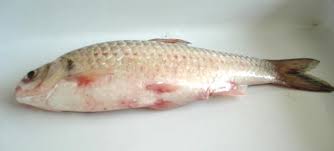MOST COMMON FUNGAL DISEASES OF FISHES
1. Argulosis:
Symptoms:
Caused due to Argulus (Fish louse). The fish scrapes itself against objects, clamped fins, visible parasites about 1/4 inch in diameter are visible on the body of the fish. The fish louse is a flattened mite-like crustacean about 5 mm long that attaches itself to the body of fish. They irritate the host fish which may have clamped fins, become restless, and may show inflamed areas where the lice have been.
Treatment:
With larger fish and light infestations, the lice can be picked off with a pair of forceps. Other cases can best be done with a 10 to 30 minute bath in 10 mg per litre of potassium permanganate or treat the whole tank with 2 mg per liter, but this method is messy and dyes the water.
 Learn More
Learn More2. Ichthyosporidium:
Symptoms:
Sluggishness, loss of balance, hollow belly, external cysts and sores.
Ichthyosporidium is a fungus, but it manifests itself internally. It primarily attacks the liver and kidneys, but it spread everywhere else. The symptoms vary. The fish may become sluggish, loosely balanced, show hollow bellies, and eventually show external cysts or sores. By then it is usually too late for the fish.
Treatment:
Phenoxethol added to food as a 1% solution may be effective. Chloromycetin added to the food has also been effective. But both of these treatments, if not watched with caution, could pose a risk to your fish. It is best, if diagnosed soon enough, to destroy the affected fish before the disease spreads.
Read also: 4 ways you can save money in fish farming business
3. Fungus (Saprolegnia):
Symptoms:
Tufts of dirty, cotton-like growth on the skin, can cover large areas of the fish, fish eggs turn white. Fungal attacks always follow some other health problems like parasitic attack, injury, or bacterial infection. The symptoms are a grey or whitish growth in and on the skin and/or fins of the fish.
Eventually, if left untreated, these growths will become cottony looking. The fungus, if left untreated, will eventually eat away on the fish until it finally dies.
Treatment:
Use a solution of phenoxethol at 1% in distilled water. Add 10 ml of this solution per litre. Repeat after a few days if needed, but only once more as three treatments could be dangerous inhabitants.
If the symptoms are severe the fish can be removed and treated with small amount of providone iodine or mercurochrome. For attacks on fish eggs, most breeders will use a solution of methylene blue adding 3 to 5 mg/1 as a preventive measure after the eggs are laid.
Like our page on Facebook HERE
For more information and updates join our WhatsApp group HERE











